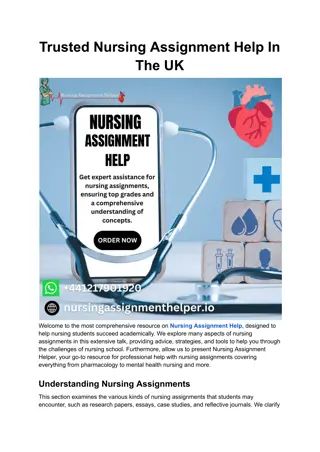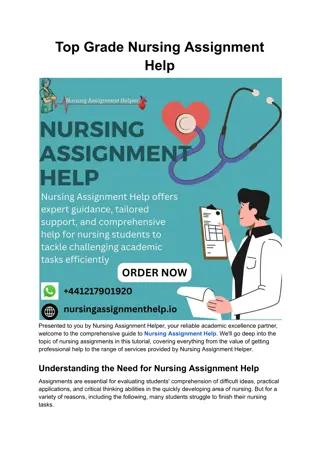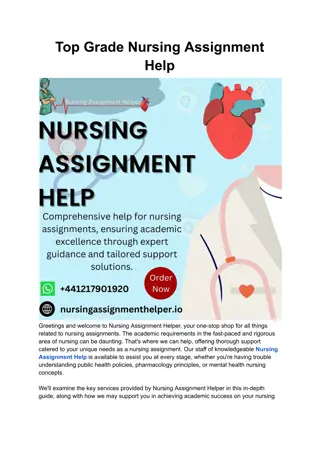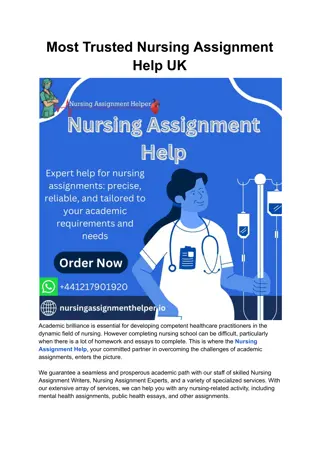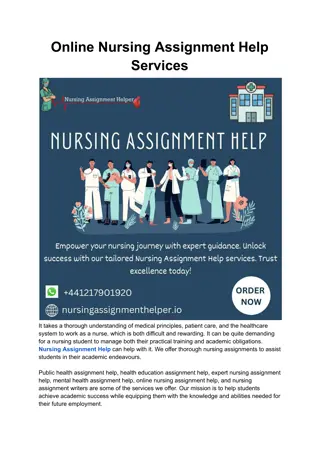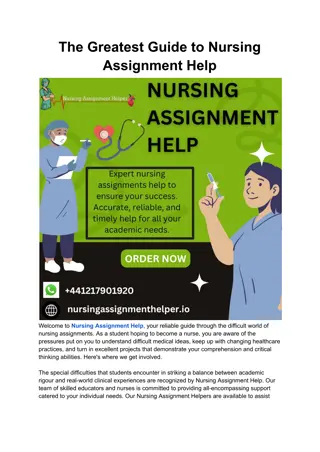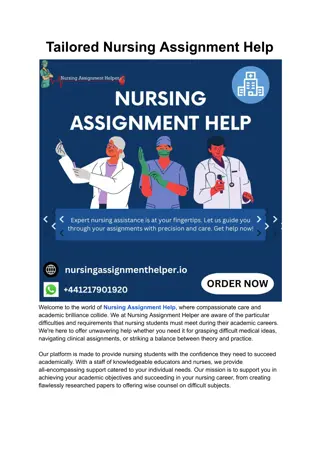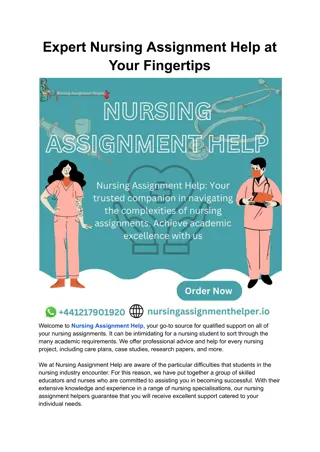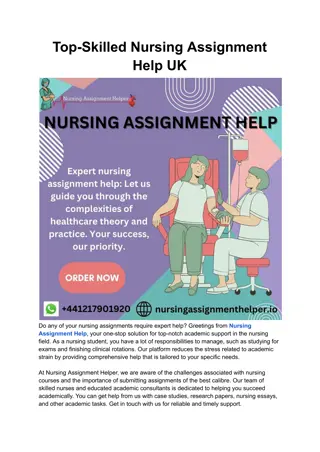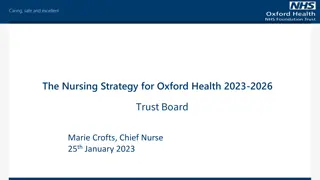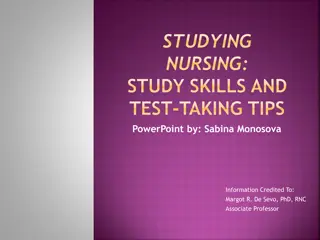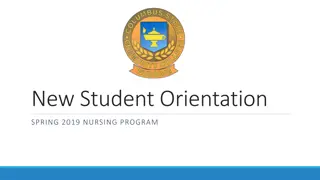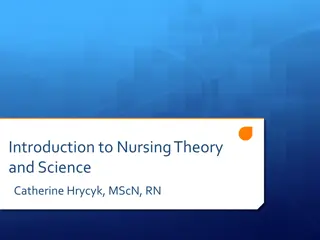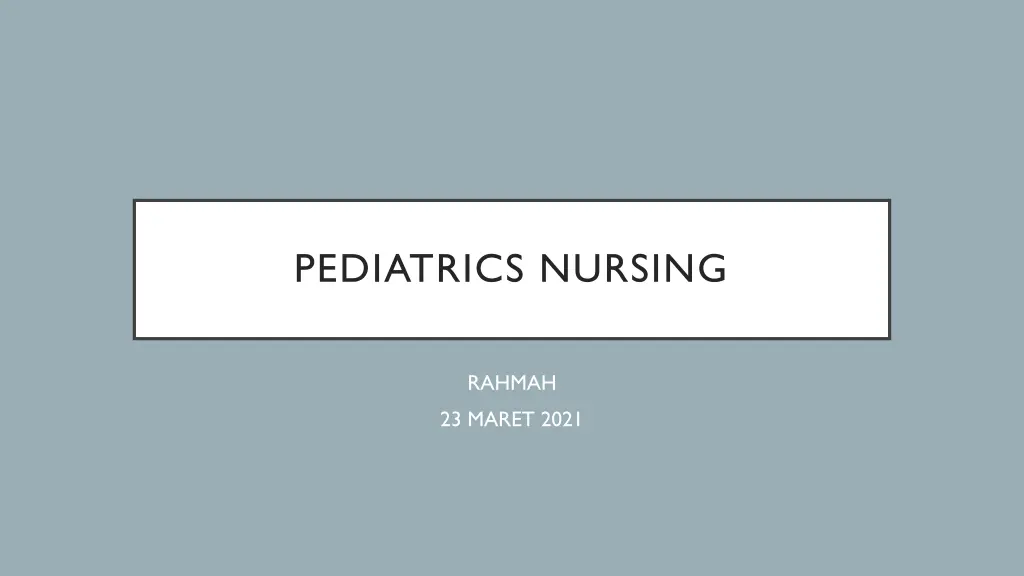
Evolution of Pediatric Nursing Through History
Explore the evolution of pediatric nursing from its early beginnings to modern practices, highlighting key milestones and advancements in the care of children's health from infancy through adolescence. Learn about the changing role of nurses, the influence of public health initiatives, and the development of specialized pediatric care over time.
Download Presentation

Please find below an Image/Link to download the presentation.
The content on the website is provided AS IS for your information and personal use only. It may not be sold, licensed, or shared on other websites without obtaining consent from the author. If you encounter any issues during the download, it is possible that the publisher has removed the file from their server.
You are allowed to download the files provided on this website for personal or commercial use, subject to the condition that they are used lawfully. All files are the property of their respective owners.
The content on the website is provided AS IS for your information and personal use only. It may not be sold, licensed, or shared on other websites without obtaining consent from the author.
E N D
Presentation Transcript
PEDIATRICS NURSING RAHMAH 23 MARET 2021
DEFINITION Pediatric nursing is the practice of nursing involved in the health care of children from infancy through adolescence. In the Indonesia the number of children younger than age 18 years is approximately 74.5 million, accounting (ChildStats.gov Forum on Child and Family Statistics,2010). for 24% of the population The definition of nursing, the diagnosis and treatment of human responses to actual or potential health problems, also applies to the practice of pediatric nursing (American NursesAssociation,2004). However, the overall goal of pediatric nursing practice is to promote and assist the child in maintaining optimal levels of health while recognizing the influence of the family on the child s well-being. This goal involves the practice of health promotion and disease prevention as well as assisting with care during disease or illness.
EVOLUTION OF PEDIATRIC NURSING During this time, health care personnel were trained to take care of children in hospitals, but parents of hospitalized children were discouraged from visiting to prevent the spread of infection. Restricting parents from being involved in their child s care was also thought to minimize emotional stress In the early 1900s, Lillian Wald established the Henry Street Settlement House in New York City; this was the start of public health nursing. This facility provided medical and other services to poor families. These services included home nurse visits to teach mothers about health care. In pediatric for awarded in the United States to Jacobi, who is known as the father of pediatrics. For the first time, the medical realized there need to specialized training and education children to physicians. 1870, the first professorship physician a was Abraham community was provide a about
EVOLUTION OF PEDIATRIC NURSING In the 1960s, changes in the health care delivery system and shifts in the population s health status led to the development of the nurse practitioner role A professional course in pediatric nursing was started in the early 1900s at Teachers College of Columbia University Nursing in public schools began in 1902 with the appointment of Lina Rogers as a full-time public school nurse in New York.
EVOLUTION OF PEDIATRIC NURSING Finally, in the 1980s, the Division of Maternal- Child Health Nursing Practice of the American Nurses Association developed maternal child health standards to provide important guidelines for delivering nursing care. In addition, the considerable changes in the US health care system in the 1980s affected pediatric nursing and child health care. The emphasis of care was on quality outcomes and cost containment. Some of these changes brought more advancedpractice nurses into the field of pediatrics. The 1970s brought cost- control systems from the federal government because of rapid escalation of health care expenditures
BECOME PEDIATRICS NURSING https://www.youtube.com/watch?v=GT-DGh9lCNs
PHILOSOPHY OF PEDIATRIC NURSING Children need access to care that is continuous, comprehensive, coordinated, family centered,and compassionate. This care needs to focus on their changing physical,developmental,and emotional needs.Pediatric nurses provide this care by focusing on the family, providing atraumatic therapeutic care, and using evidence-based practice Parents or guardians play a critical role in the health and well-being of children. Providing care through a family- centered approach leads not only to better outcomes but also to better consumer satisfaction. The family is the child s primary source of support and strength. The knowledge that the family has about a child s health or illness is vital.Family-centered care involves a mutually beneficial partnership between the child, the family, and health care professionals
PHILOSOPHY OF PEDIATRIC NURSING Children may undergo a wide range of interventions, many of which can be traumatic, stressful, and painful. The various settings in which the child receives care can be scary and overwhelming to the child and family, and interacting with health care personnel in various settings can cause anxiety. Thus, another major component of the pediatric nursing philosophy is providing atraumatic care. This is a philosophy of providing therapeutic care through interventions that minimize physical and psychological distress for children and their families Evidence-based practice involves the use of research findings in establishing a plan of care and implementing that care. It is a clinical decision-making approach involving the integration of the best scientific evidence,patient values and preferences, clinical circumstances, and clinical expertise to promote best outcomes (Salmond, 2007). It is important that nurses develop the skills and knowledge necessary to ask pertinent clinical questions, search for current best evidence, analyze the evidence, integrate the evidence into practice when appropriate, and evaluate outcomes. Evidence-based practice may lead to a decrease in variations in care while at the same time increasing quality and improving health care.
PHILOSOPHY OF PEDIATRIC NURSING Evidence-based practice involves the use of research findings in establishing a plan of care and implementing that care. It is a clinical decision-making approach involving the integration of the best scientific evidence,patient values and preferences, clinical circumstances, and clinical expertise to promote best outcomes (Salmond, 2007). It is important that nurses develop the skills and knowledge necessary to ask pertinent clinical questions, search for current best evidence, analyze the evidence, integrate the evidence into practice when appropriate, and evaluate outcomes. Evidence-based practice may lead to a decrease in variations in care while at the same time increasing quality and improving health care.
ROLE OF THE PEDIATRIC NURSE https://www.youtube.com/watch?v=O81ZY9wHhHw The primary role of the pediatric nurse is to provide direct nursing care to children and their families,being an advocate,educator,and manager. As a child and family advocate, the nurse safeguards and advances the interests of children and their families by knowing their needs and resources, informing them of their rights and options, and assisting them to make informed decisions. In the role of educator, the nurse instructs and counsels children and their families about all aspects of health and illness. The pediatric nurse ensures that communication with the child and family is based on the child s age and developmental level. The pediatric nurse uses and integrates research findings to establish evidence- based practice, managing the delivery of care in a cost-effective manner to promote continuity of care and an optimal outcome for the child and family.
PHILOSOPHY OF PEDIATRIC NURSING The pediatric nurse also serves as a collaborator, care coordinator, and consultant. Collaborating with the interdisciplinary health care team, the pediatric nurse integrates the child s and family s needs into a coordinated plan of care. In the role of consultant, the pediatric nurse ensures that the child s and family s needs are met through such activities as support group facilitation or working with the school nurse to plan the child s care. The dimensions of pediatric health care are changing. We live in a global community in which distances have been minimized, enabling all of us to learn, share,and exchange information. The pediatric nurse needs to be alert to the wide-ranging developmental and mental health needs of children as well as to the traits and behaviors that may lead to serious health problems. The scope of pediatric health care practice is much broader today, and pediatric nurses must include quality evidence-based interventions when developing the plan of care. In addition, pediatric nurses must incorporate new information about genetics and neurobiology and must continue to keep up with the technology explosion.
PHILOSOPHY OF PEDIATRIC NURSING Providing Culturally Focused Care The United States is no longer a melting pot of various cultures and ethnicities but a society in which each distinct individual brings a diversity and richness that as a whole enriches the country. Today, children do not fit into a set category or group. Children and families vary in terms of culture, family structure, socioeconomic status, background, and circumstances, so each child enters the health care system as a unique individual. Pediatric nurses must have greater sensitivity to the background of each child and must be able to provide care that addresses the child s uniqueness.
PHILOSOPHY OF PEDIATRIC NURSING Providing Care Across the Health Illness Continuum As a result of improved diagnosis and treatment, the pediatric nurse now cares for children who have survived once-fatal situations, are living well beyond the usual life expectancy for a specific illness, or are functioning and attending school with chronic disabilities. While positive and exciting, these advances and trends pose new challenges for the health care community. For example,as care for premature newborns improves and survival rates have increased, so too has the incidence of long-term chronic conditions such as respiratory airway dysfunction or developmental delays. As a result, pediatric nurses care for children at all stages along the health illness continuum, from well children, to those who are occasionally ill, to those with chronic, sometimes disabling conditions.
PHILOSOPHY OF PEDIATRIC NURSING Providing Family-Centered Care Due to the influence of managed care, the focus on prevention, better education, and technological advances, people have taken increased responsibility for their own health. Parents now want information about their child s illness, they want to participate in making decisions about treatment, and they want to accompany their children to all health care situations. As child advocates who value family-centered care, pediatric nurses can provide such empowerment and can address specific issues for children and families. Pediatric nurses must respect the family s views and concerns, address those issues and concerns,regard the parents as important participants in their child s health, and always include the child and family in the decision-making process
PHILOSOPHY OF PEDIATRIC NURSING Providing Preventative Care Efforts to reduce costs have also led to an increased emphasis on preventive care. Anticipatory guidance is vital during each health contact with children and their families. Education of the family includes everything from keeping the home safe to preventing illness. These are major points of emphasis for pediatric nurses as they deliver care to children and their families.
PHILOSOPHY OF PEDIATRIC NURSING Providing Continuum of Care In an effort to become more cost-effective and to provide care more efficiently, the nursing care of children now encompasses a continuum of care that extends from acute care settings such as hospitals to outpatient settings such as ambulatory care clinics, primary care offices, rehabilitative units, community care settings, long-term facilities, homes, and schools. For example, after an acute hospital stay, a child may be able to complete therapy at home, school, or another community setting and can re-enter the hospital for short periods for specific treatments or illness. This continuum of care works well for children, since current statistics indicate that among children who have a regular place for care, 75% usually receive their medical care in doctors offices, 24% in clinics, 1% in hospital based clinics, and 1% in hospital emergency rooms
PHILOSOPHY OF PEDIATRIC NURSING Providing Child and Family Teaching The nurse s role in relation to morbidity and mortality in children involves educating the family and community regarding the usual causes of deaths, the types of childhood illnesses, and the symptoms that require health care. The goal is to raise awareness and provide guidance and counseling to prevent unnecessary deaths and illnesses in children. The health of children is basic to their wellbeing and development,and the attention given to children s health in this country has slowly increased over the years. The pediatric nurse is in an excellent position to improve the future health of children.
PHILOSOPHY OF PEDIATRIC NURSING Participating components of contemporary nursing practice. in Research Pediatric nursing involves all the essential The pediatric nurse makes use of theories and research pertaining specifically to children as well as general nursing concepts and research. Nurses must know about current trends in child health so that they can provide appropriate anticipatory guidance,counseling,and teaching for children and families and can identify high-risk groups so that interventions can be initiated early,before illness or death occurs.
PHILOSOPHY OF PEDIATRIC NURSING Implementing the Nursing Process The pediatric nurse performs all of these tasks using the framework of the nursing process. The nursing process is used to care for the child and family during health promotion, maintenance, restoration, and rehabilitation. It is a problem-solving method based on the scientific method that allows nursing care to be planned and implemented in a thorough, organized manner to ensure quality and consistency of care. The nursing process is applicable to all health care settings and consists of five steps: assessment, nursing diagnosis, outcome implementation,and outcome evaluation. identification and planning, 1. Assessment. Assessment involves collecting data about the child and family and performing physical assessment during community based health services, at admission to an acute care setting, at periodic times during the child s hospitalization or care,and during home care visits. 2. Nursing diagnosis. The nurse analyzes the data to make judgments about the child s health and developmental status. The nursing diagnoses that result from this judgment process describe health promotion and health patterns that pediatric nurses can manage. .
PHILOSOPHY OF PEDIATRIC NURSING 3. Planning and expected outcomes. The next step in the process involves developing nursing care plans that incorporate goals or expected outcomes that improve the child s dysfunctional health patterns, promote appropriate health patterns,or provide for optimal developmental outcomes.The care plan includes the specific nursing actions that assist in obtaining the outcomes. 4. Implementation. These interventions are implemented, adapted to the child s developmental level and family status, and modified if the child s response indicates the need. The care plan incorporates the family in addition to the child. 5. Evaluation. The process is continually evaluated and updated during the partnership with the child and family. Standardized care plans for specific nursing diagnoses and critical pathways for case management are often used in various pediatric settings. In general, care plans and critical pathways are becoming more evidence based, using a combination of research, group consensus, and past health care decisions to identify the most effective interventions for the child and family. The nurse is responsible for individualizing these standardized care plans based on the data collected during the assessment of the child and family and for evaluating the child s and family s response to the nursing interventions.
PEDIATRICS NURSING IN VARIOUS SETTING Nursing Practice Roles in Various Health Care Settings The professional pediatric registered nurse provides care for children in a variety of settings. Acute care focuses on the diagnosis and treatment of illness and occurs in such settings as general pediatric hospital units, pediatric intensive care units, emergency departments, ambulatory clinics, surgical centers, and psychiatric centers. In the community the focus is usually on health promotion and illness prevention.Various community settings include health clinics or offices,schools, homes, day care centers, and summer camps. Care involving restorative, rehabilitative, or quality-of-life care generally takes place in rehabilitation centers or hospice programs or through service with a home health agency
PEDIATRICS NURSING IN VARIOUS SETTING There are various practice roles where the nurse s experience, competence, and educational level determine the nurse s position. For example, a clinical coordinator typically holds a baccalaureate degree and fills a leadership role in a variety of settings. The case manager,also usually a baccalaureate-prepared nurse,is responsible for integrating care from before admission to after discharge. The case manager coordinates the implementation of the interdisciplinary team in a collaborative manner to ensure continuity of care that is cost-effective,quality oriented,and outcome focused. Various changes in the health care system continue to encourage the development of the advanced practice role for pediatric nursing. The advanced practice role is an expanded nursing role that requires additional education and skills in the assessment and management of children and their families. The pediatric nurse practitioner (PNP) has a master s degree and national certification in the specialty area. The PNP is an independent and autonomous practitioner. The PNP provides health maintenance care for children (such as well-child examinations and developmental screenings) and diagnoses and treats common childhood illnesses. He or she manages children s health in primary, acute, or intensive care settings or provides long-term management of the child with a chronic illness. The family nurse practitioner (FNP) and neonatal nurse practitioner (NNP) function in a similar manner to the PNP but provide care to individuals throughout the lifespan and to newborns,respectively. The clinical nurse specialist has a master s degree and provides expertise as an educator, clinician, or researcher,meeting the needs of staff,children,and families.
PEDIATRICS NURSING STANDARDS Standards of Care and Performance in Today s Environment In any role, the professional pediatric nurse is held accountable for nursing actions that adhere to the standards of care. A standard of care is a minimally accepted action expected of an individual of a certain skill or knowledge level and reflects what a reasonable and prudent person would do in a similar situation. Professional standards from regulatory agencies,state or federal laws, nurse practice acts, and other specialty groups regulate nursing practice in general. The National Association of Pediatric Nurse Practitioners (NAPNAP), the Society of Pediatric Nurses (SPN), and the American Nurses Association (ANA) have formulated specific standards of care and professional performance for pediatric clinical nursing practice These standards are tools that determine if care constitutes adequate, effective, and acceptable nursing practice. They also serve as guides and legal measures for this special area of practice. These standards promote consistency in practice, provide important guidelines for care planning, assist with the development of outcome criteria, and ensure quality nursing care. The ANA-SPN standards specify what is adequate and effective for general pediatric nursing and promote consistency in practice.
ETHICAL ISSUES Ethical Issues Related to Working With Children and Their Families Pediatric nurses must examine their own values so that they can provide nursing care in an ethical manner. Each situation must be evaluated individually. The nurse s relationship with the child and family is of prime importance. Every day pediatric nurses encounter families from a wide variety of religious, cultural, and ethnic backgrounds, and it is critical to treat each family with respect. Family centered care focuses on the needs of the child and family together and involves ethical treatment of the child. Advances in science and technology have led to an increased number of ethical dilemmas in health care. Many facilities have formed institutional ethics committees.These committees not only provide case-by- case review and resolution of ethical dilemmas but also review existing institutional policies and provide education to staff,physicians,children,and families on ethical issues (Nelson,2007)
ETHICAL ISSUES Practicing ethically begins with being sensitive to the sanctity and quality of human life. An ethical nurse is accountable and uses sound reasoning to resolve ethical challenges. Ethics includes the basic principles of autonomy, beneficence, nonmaleficence, justice, veracity, and fidelity. The nurse must understand these principles in order to analyze and respond to ethical dilemmas. Autonomy refers to the freedom to choose and self-determination in regard to making health care decisions. Generally,parents have the autonomy to make health care decisions for their child.In certain situations, however,older children have the autonomy to give assent to care (see below), and in special situations, adolescents are granted the autonomy to consent to health care procedures without the parents knowledge. Beneficence refers to actions that will benefit others. In pediatric care this means actions of kindness that will benefit the child rather than harming him or her. Nonmaleficence means avoiding causing harm,intentionally or unintentionally. Justice refers to acting fairly.Treatment decisions will not be based on factors such as age,gender,religion,socioeconomic status, or ethnic group. Veracity is telling the truth and fidelity is keeping promises and maintaining confidentiality and privacy. The pediatric nurse must balance these ethical components when dealing with families from a variety of cultural and religious backgrounds who are making health care decisions for their children.
THE PROCESS IS AS FOLLOWS: 1.Identify the problem. 2.Gather information about the problem. 3.Weigh the risks against the benefits. 4.Choose a solution. 5.Implement the solution. 6.Evaluate the outcome of the situation. Many pediatric institutions have adopted a bill of rights for children s health care.This might include the right: To be called by name To receive compassionate health care in a careful, prompt, and courteous manner To know the names of all providers caring for the child To have basic needs met and usual schedules or routines honored To make choices whenever possible To be kept without food or drink when necessary for the shortest time possible To be unrestrained if able To have parents or other important persons with the child To have an interpreter for the child and family when needed To object noisily if desired To be educated honestly about the child s health care To be respected as a person (not having people talk about the child within earshot unless the child knows what is happening) For all physicians to respect the child s confidentiality about his or her illness at all times
ETHICAL ISSUES Legal Issues Related to Working With Children and Their Families Minors (children younger than 18 years of age) generally require adult guardians to act on their behalf. Parents ultimately are the decision makers for their children. Biological or adoptive parents are usually considered to be the child s legal guardian.When divorce occurs, one or both parents may be granted custody of the child. In certain cases (such as child abuse or neglect, or during foster care), a guardian may be appointed by the courts. This person generally serves to protect the child s best interests. States generally require parental or guardian consent for minors to receive medical treatment, but some exceptions exist. Confidentiality of patient information should always be maintained within the context of the state law and the institution s policies. Consent Generally, only persons over the age of majority (18 years of age) can legally provide consent for health care. Since children are minors, the process of consent involves obtaining written permission from a parent or legal guardian. In cases requiring a signature for consent,usually the parent gives consent for care for children younger than 18 years of age except in certain situations
INFORM CONSENT INFORMED CONSENT Most care given in a health care setting is covered by the initial consent for treatment signed when the child becomes a patient at that office or clinic or by the consent to treatment signed upon admission to the hospital or other inpatient facility. Certain procedures,however,require a specific process of informed consent. Procedures that require informed consent include major and minor surgery; invasive procedures such as lumbar puncture or bone marrow aspiration;treatments placing the child at higher risk,such as chemotherapy or radiation therapy;procedures or treatments involving research;application of restraints;and photography involving children. The informed consent process, which must be done before the procedure or specific care, addresses the legal and ethical requirement of informing the child and parent about the procedure. It originates from the right of the child and family to direct their care and the ethical responsibility of physicians to involve the child and family in health care decisions. Nurses should involve children and adolescents in the decision-making process to the extent possible, though the parent is still ultimately responsible for giving consent. The physician or advanced practitioner providing or performing the treatment and/or procedure is responsible for informing the child and family about the procedure and obtaining consent by providing a detailed description of the procedure or treatment,the potential risks and benefits,and alternative methods available. The nurse s responsibility related to informed consent includes the following: Determining that the parents or legal guardians understand what they are signing by asking them pertinent questions Ensuring that the consent form is completed with signatures from the parents or legal guardians Serving as a witness to the signature process
INFORM CONSENT KEY ELEMENTS OF INFORMED CONSENT The decision maker must be of legal age in that state, with full civil rights, and be competent (have the ability to make the decision). Present information that is simple, concise, and appropriate to the level of education and language of the individual responsible for making the decision. The decision must be voluntary, without coercion, force, or influence of duress. Have a witness to the process of informed consent. Have the witness sign the consent form.
INFORM CONSENT SPECIAL SITUATIONS TO INFORMED CONSENT There are special situations related to informed consent. If the parent is not available, then the person in charge (relative, babysitter, or teacher) may give consent for emergency treatment if that person has a signed form from the parent or legal guardian allowing him or her to do so. During an emergency situation, a verbal consent via the telephone may be obtained. Two witnesses must be listening simultaneously and will sign the consent form, indicating that consent was received via telephone. Physicians can provide emergency treatment to a child without consent if they have made reasonable attempts to contact the child s parent or legal guardian (American Academy of Pediatrics,2007c). In urgent or emergent situations,appropriate medical care never should be delayed or withheld due to an inability to obtain consent (American Academy of Pediatrics, 2007c). Certain federal laws, such as the Emergency Medical Treatment and Labor Act (EMTALA), require that every child who presents at an emergency department is given a medical examination regardless of informed consent or reimbursement ability (AmericanAcademy of Pediatrics,2007c).
INFORM CONSENT EXCEPTIONS TO PARENTAL CONSENT REQUIREMENT In some states, a mature minor may give consent to certain medical treatment. The physician must determine that the adolescent (usually older than 14 years of age) is sufficiently mature and intelligent to make the decision for treatment. The provider also considers the complexity of the treatment, its risks and benefits, and whether the treatment is necessary or elective before obtaining consent from a mature minor (American Academy of Pediatrics, 2007c). State laws vary in relation to the definition of an emancipated minor and the types of treatment that may be obtained by an emancipated minor (without parental consent). The nurse must be familiar with the particular state s law.Emancipation may be considered in any of the following situations, depending on the state s laws: Membership in a branch of the armed services Marriage Court-determined emancipation Financial independence and living apart from parents College attendance Pregnancy Mother younger than 18 years of age Runaway
INFORM CONSENT The emancipated minor is considered to have the legal capacity of an adult and may make his or her own health care decisions (AmericanAcademy of Pediatrics,2007c). Many states do not require consent or notification of parents or legal guardians when providing specific care to minors. Depending on the state law, health care may be provided to minors for certain conditions,in a confidential manner,without including the parents. These types of care may include pregnancy counseling, prenatal care, contraception, testing for and treatment of sexually transmitted infections and communicable diseases (including HIV), substance abuse and mental illness counseling and treatment, or health care required as a result of a crime- related injury (AmericanAcademy of Pediatrics,2007c). These exceptions allow children to seek help in a confidential manner; they might otherwise avoid care if they were required to inform their parents or legal guardian. Again, laws vary by state, so the nurse must be knowledgeable about the laws in the state where he or she is licensed to practice.
INFORM CONSENT PARENTAL REFUSAL OF MEDICALTREATMENT Parental autonomy (the right to decide for or against medical treatment) is a fundamental, constitutionally protected right but not an absolute one. The general assumption is that parents act in the best interest of their children. Ideally, medical care without informed consent should be given only when the child s life is in danger.In some cases parents may refuse medical treatment for their child. This refusal may arise when treatment conflicts with their religious or cultural beliefs, and the nurse should be aware of some of these common beliefs. Some religions, such as Jehovah s Witnesses, Christian Science, Pentecostal, Faith Assembly, and Evangelical Healers, prefer prayer or faith healing over allopathic medicine (Linnard-Palmer & Kools,2004). Jehovah s Witnesses refuse blood product administration based on their religious beliefs.The Muslim refuses pork-based food,medicines or treatments.Hindus may refuse beef-based foods and medicines.Persons from an Islamic background may refuse the use of any potentially addictive substances such as narcotics or medicines containing alcohol (Linnard-Palmer & Kools, 2004). Sometimes common ground may be reached between the family s religious or cultural beliefs and the health care team s recommendations; communication and education are the keys in this situation.
INFORM CONSENT In other cases,parents may refuse treatment if they perceive that their child s quality of life may be significantly impaired by the medical care that is offered. The health care team must appropriately educate the family and communicate with them on a level that they can understand. The child and family should be informed of what to expect with certain tests or treatments. The health care team should make a clinical assessment of the child s and family s understanding of the situation and their reasons for refusing treatment. Active listening may allow the physician to address the concerns, fears, or reservations the family may have regarding their child s care. Refusal of medical care may be considered a form of child neglect. If providing medical treatment may prevent substantial harm or suffering or save a child s life,physicians and the judicial system strive to advocate for the child.The state has an overriding interest in the health and welfare of the child and can order that medical treatment proceed without signed informed consent;this is referred to as parents patriae (the state has a right and a duty to protect children). If the parents refuse treatment and the health care team feels the treatment is reasonable and warranted, the case should be referred to the institution s ethics committee. If the issue remains unresolved or in complex cases, the judicial system may become involved
ASSENT Assent means agreeing to something. In pediatric health care, the term assent refers to the child s participation in the decision-making process about health care (McCullough & Stein,2009). The age of assent depends on the child s developmental level, maturity, and psychological state. The American Academy of Pediatrics recommends that children and adolescents be involved in the discussions about their health care and kept informed in an age-appropriate manner (American Academy of Pediatrics, 2007a). Federal guidelines do not suggest a specific age when assent should be obtained,but the American Academy of Pediatrics proposes that a child with an intellectual age of 7 years or older is competent to understand participation in research and therefore provide assent (Knox & Burkhart,2007). As a child gets older assent or dissent should be given more serious consideration.The pediatric patient needs to be empowered by physicians to the extent of their capabilities, and as children mature and develop over time they should become the primary decision maker regarding their health care (American Academy of Pediatrics, 2007a). The American Academy of Pediatrics recommends that if a physician asks the child s opinion about the direction of treatment or participation in research, then the child s view and desires should be seriously considered
ASSENT When obtaining assent, first help the child to understand his or her health condition, depending on the child s developmental level. Next, inform the child of the treatment planned and discuss what he or she should expect. Then determine what the child understands about the situation and make sure he or she is not being unduly influenced to make a decision one way or another.Lastly,ascertain the child s willingness to participate in the treatment or research (AmericanAcademy of Pediatrics,2007a;McCullough & Stein,2009). Assent is a process and should continue throughout the course of treatment or research protocol. The converse of assent,dissent (disagreeing with the treatment plan),when given by an adolescent 13 to 17 years of age, is considered binding in some states. If the physician is not going to honor the child s dissent, the argument can be made that he or she should not ask for the child s assent. .




